10 Microsoft Power Automate alternatives to try in 2026

If you’re reading this I know you want to find the best Microsoft Power Automate alternative on the market.
Maybe you’re not happy with your current setup, or you’re looking for a tool that is easier to use. Or maybe you need a platform that AI-native and can integrate with your existing tech stack.
Whatever the case may be, I’ve tested probably over 35 different automation tools in the past 9 months. And I’ve narrowed down my list to just 10 that I believe to be the best alternatives to using Power Automate.
I’ll also tell you which tool is best for what, its top use cases, and my pros and cons of each. I tried to keep it as unbiased as possible. This way, you can find the right alternative that actually fits your specific use case and stage in your business.
But before I show you the list, let’s go over what you should pay attention to when evaluating these types of tools.
What to look for in a Power Automate alternative?
When comparing Microsoft Power Automate alternatives, it’s important to know what to actually look for. Most blogs on this topic just tell you a list of alternatives but don’t really tell you how to evaluate them for yourself.
After all, I don’t know all of the nuances with your business. Only you know them. So first let’s go over what you should consider when finding an alternative. This way, you can pick the right tool for the stage of business you’re at (and the use case you need it for).
Here’s what you should look for when considering a Power Automate alternative:
- Has AI capabilities that can integrate with any LLM model on the market. Some tools only let you connect with ChatGPT. While others allow you to connect to that plus Claude, Grok, DeepSeek, Llama, Gemini, and more. This will allow you to pick the right model for the right job.
- Has great UI/UX. You’re going to be using this tool a lot to set up automations. Make sure you pick a platform you actually like using on a regular basis. Most of these tools either have free or trial accounts, so you can play around with them before you commit.
- Templates or AI assistants to help you build workflows. Unless you already have a very specific workflow you want to automate, sometimes it can be confusing to know how to approach an automation tool. So find a tool that has pre-built templates for ideas or has an AI assistant that can walk you through the development process.
- Debugging features. It’s quite rare to set up an automated workflow without first having to go through a few head scratching moments. I know I ran into a lot of roadblocks my first time, but the right tool knows this is going to happen to you. And when it does, it will tell you exactly what to do to solve the problem.
- Scalability and privacy. Once you set up an automation, you sort of don’t look at it anymore (assuming it doesn’t break). So you want to pick a tool that can handle scale, this way you don’t have to worry about switching platforms and having to recreate all of your workflows from scratch. Also, on privacy, you want to make sure the platform you pick doesn’t train on your data.
Being aware of these things will allow you to find a tool that is actually worth your time and effort. For each tool I recommend below, I went through and listed who it’s best for, it’s top use cases, and the pros and cons of each. This way, you can evaluate them to the points above as you go through them.
Alright, now let’s get into the top Microsoft Power Automate alternatives.
10 best Power Automate alternatives & competitors
Here are the top Microsoft Power Automate alternatives:
Okay, let’s take a deeper look at each one.
1. Gumloop

- Best for: Building AI-powered workflow automations without needing to code
- Pricing: Free plan available, paid plans start at $37/month
- What I like: The AI copilot (Gummie) can literally build workflows for you just by describing what you need
Gumloop is an AI-first workflow automation and AI agent builder platform. It's become one of the most popular tools to build automated workflows, and it's used internally by companies like Shopify, Webflow, and Instacart.
What makes Gumloop different than Microsoft's Power Automate is that it's built with AI as the foundation. Meaning you can create any automated workflow using the tools you may already have in your tech stack (with APIs), but you can also connect all your tools to any AI model like ChatGPT, Claude, Llama, DeepSeek, and more.

Top use cases
Here are some of Gumloop's top use cases:
- Marketing automation: Automate anything from competitor research, scraping web data, building lead generation workflows, integrating with SEO tools, and creating social listening AI agents.
- Sales automation: Create personalized outreach campaigns, integrate with any CRM to enrich contact information, build research reports on prospects, build Slack AI agents that can send notifications when leads come in, and a ton more.
- Operations: Extract data from any source and categorize it with AI, build lead scoring workflows, create triggers that can send emails, build AI agents that can read your payment database and execute on custom actions, and more.
- Customer support: Read support tickets and use AI to categorize them, create a Slack bot that notifies your team with high-priority tickets, send weekly reports on customer sentiment analysis, and a ton more.
As you can see, Gumloop is built for all departments. And you can literally build any AI-powered automation using either their drag-and-drop no-code interface, or simply talk to Gummie (the AI chatbot) and tell it exactly what automation to build for you.
It's a complete end-to-end platform to help you automate anything at work. And it's used by everyone from solo operators to large enterprise teams with hundreds of employees.
If you're looking for a Microsoft Power Automate alternative that is a bit more user-friendly and gives you everything in an all-in-one platform, Gumloop is definitely a platform to check out.
Pros and cons
Here are Gumloop's pros:
- Can integrate with any LLM model (with premium subscriptions built into one plan)
- Has an AI assistant, Gummie, that can build out any automated workflow simply by talking to it
- Clean and simple UI/UX that is easy to understand for any beginner or expert automation enthusiast
- Great for non-technical users
- Can handle almost any complex workflow
Here are some of Gumloop's cons:
- While easy to use, larger workflows can get tricky if you don't organize your subflows properly
- The platform is still new and emerging, so new features are constantly being shipped, and it can sometimes change the way the UI looks
Overall, Gumloop is my favorite platform for building AI automated workflows. I truly believe it is one of the best, or else I wouldn't spend my Tuesday morning writing this article. Just to note, I don't work at Gumloop. I'm just a customer that really loves the platform.
Gumloop pricing

Here are Gumloop's pricing plans:
- Free: 2k credits/month, 1 seat, 1 active trigger, 2 concurrent runs, unlimited nodes and flows, Gummie agent, and forum support
- Solo ($37/month): 10k+ credits/month, unlimited triggers, 4 concurrent runs, webhooks, email support, and bring your own API key
- Team ($244/month): 60k+ credits/month, 10 seats, 5 concurrent runs, unlimited workspaces, unified billing, dedicated Slack support, and team usage & analytics
- Enterprise (custom pricing): Everything in Team plus role-based access control, SCIM/SAML support, admin dashboard, audit logs, custom data retention rules, regular security reports, data exports, incognito mode, and AI model access control
If you want to compare the different plans, you can check out the pricing page here.
Gumloop reviews
Here are what customers of Gumloop say about the platform:
"Gumloop has been critical in helping all teams at Instacart - including those without technical skills - adopt AI and automate their workflows, which has greatly improved our operational efficiency."
— Fidji Simo, CEO @ Instacart
"Gumloop wins time back across an org. It puts the tools into the hands of people who understand a task and lets them completely automate it away."
— Bryant Chou, Co-Founder @ Webflow
2. n8n

- Best for: Technical teams building complex workflow automations
- Pricing: Free plan available, paid plans start at $24/month
- What I like: Has over 6,000 pre-built workflow templates and a huge community of developers sharing resources
n8n is an AI workflow automation tool built for technical teams. It has a drag-and-drop interface similar to Gumloop, however n8n is more of a low-code platform that does take a bit of a learning curve to get used to.
You can use n8n to build automations in IT, department security, office DevOps, sales, and even marketing. And it's used by a lot of AI automation agencies and larger companies like Zendesk, Vodafone, and Wayfair.
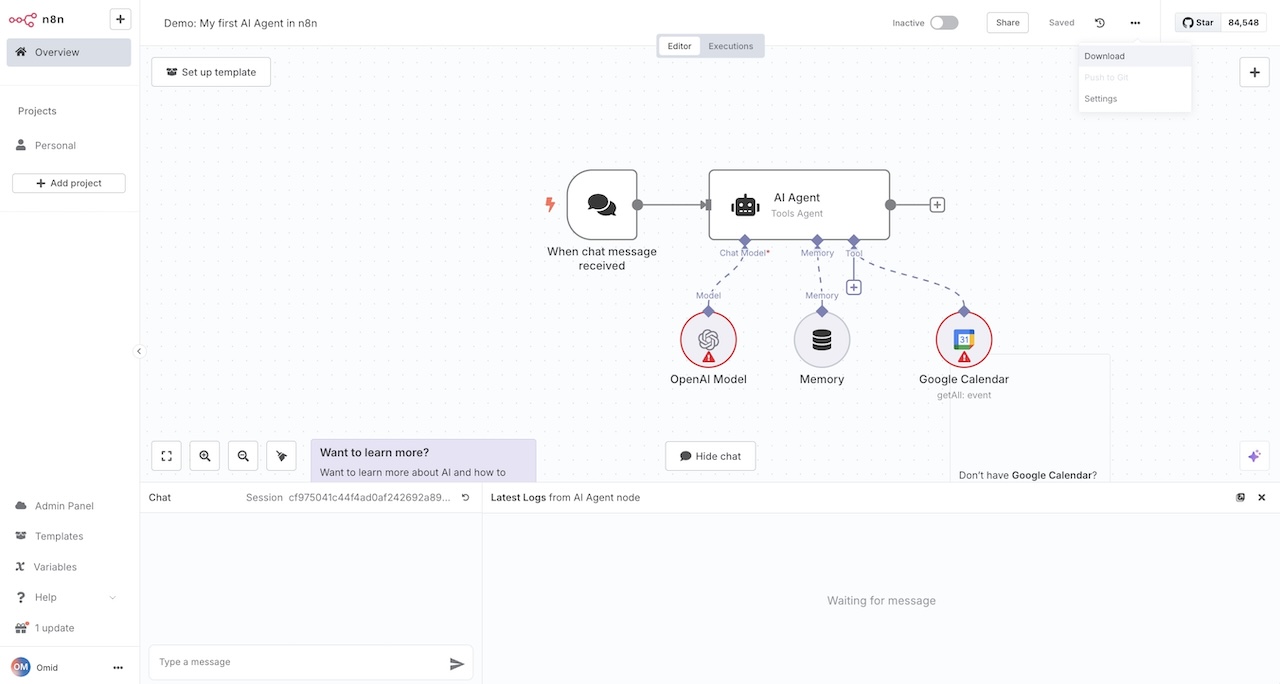
Top use cases
Some top use cases for n8n include things like:
- IT operations: Build workflows that can create SOPs and process docs with consistency, create help desk and ticketing features, understand employee life cycle, help automate IT infrastructure, and more.
- Security operations: Host your own uptime monitoring with scheduled triggers, test internal workflows step by step, use AI to help with debugging, and more.
- Backend prototyping: Quickly set up a SaaS backend to test and increase the speed of learning, improve efficiency across different business processes, use AI to analyze your code, and more.
As you can see, more toward technical use cases. While you can use it for some marketing use cases, as a lot of people have used it to automate blog writing (which I don't recommend), it's mostly best for developers who want to speed up prototyping in a visual interface.
n8n pros and cons
Here are some of n8n's pros:
- Includes over 6,000 workflow automation templates to get started with
- Is very popular so there are lots of educational resources and tutorials on YouTube
- A developer-friendly platform with lots of complex automation capabilities
- Fairly priced compared to other tools in this space
Here are some n8n cons:
- Can have a steep learning curve if you are not technical
- You need to use your own LLM API keys to leverage AI functions (unlike Gumloop that includes them)
- The UI/UX can feel a bit clunky
Overall, n8n is an extremely powerful alternative to Power Automate. If you have a technical background and you want to build automations and prototypes really fast, then it's definitely a tool to check out.
n8n pricing
Here are n8n's pricing plans:
- Starter ($24/month): 2.5k workflow executions with unlimited steps, 1 shared project, 5 concurrent executions, unlimited users, forum support, and hosted by n8n
- Pro ($60/month): 10k workflow executions with unlimited steps, 3 shared projects, 20 concurrent executions, 7 days of insights, admin roles, global variables, workflow history, and execution search
- Business ($800/month): 40k workflow executions with unlimited steps, 6 shared projects, SSO/SAML and LDAP, 30 days of insights, different environments, scaling options, version control using Git, forum support, and self-hosted or hosted by n8n
- Enterprise (contact sales): Custom number of workflow executions, unlimited shared projects, 200+ concurrent executions, 365 days of insights, external secret store integration, log streaming, extended data retention, dedicated support with SLA, and invoice billing
If you want to compare the different plans, you can check out the pricing page here.
n8n reviews
Here's what customers rate n8n on third-party review sites:
- G2: 4.8/5 star rating (from +166 user reviews)
- Capterra: 4.6/5 star rating (from +39 user reviews)
3. Zapier
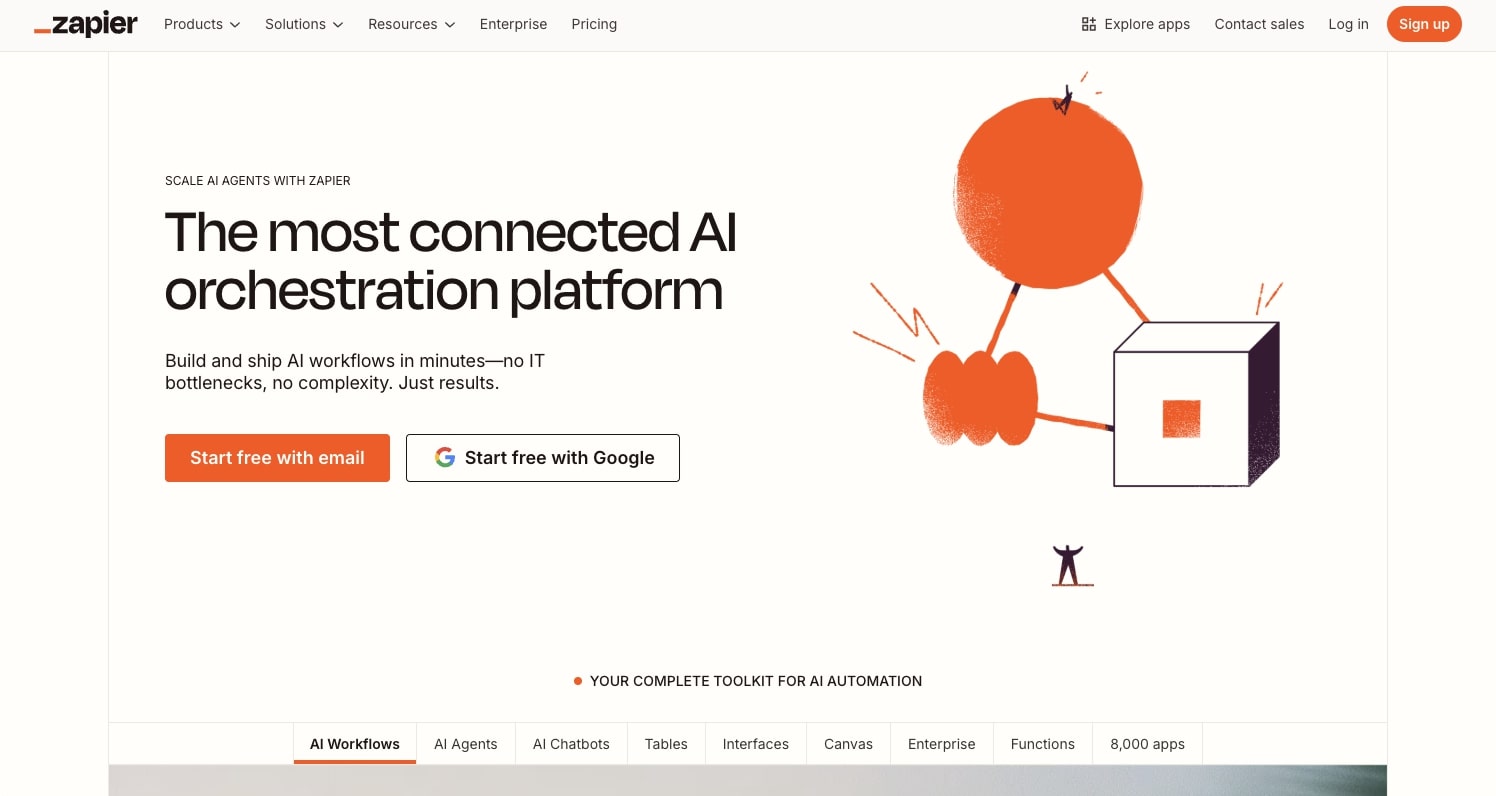
- Best for: Connecting apps with simple "if this, then that" automation logic
- Pricing: Free plan available, paid plans start at $29.99/month
- What I like: The massive integration library means you can connect almost any tool you're already using
Zapier is an AI workflow orchestration platform that helps you connect your existing tools to create automated workflows. It's one of the OGs when it comes to automation platforms and probably the most popular alternative to Microsoft's Power Automate.
With Zapier, you can create everything from AI workflows to AI chatbots and now even AI agents. The platform has a large library of app integrations that you can use to create "if this, then that" logic between them.

It's very similar to Power Automate in that you can use it to connect different apps together to automate repetitive tasks.
Top use cases
Here are some top use cases for Zapier:
- RevOps: You can use Zapier for connecting your GTM tools to create custom workflows across your marketing, sales, support, and success teams.
- Marketing: You can use Zapier to connect your marketing tools like Mailchimp, Google Ads, ChatGPT, and more to create automated workflows.
- IT: You can create streamlined workflows across platforms like Postgres, Pendo, Zendesk, Slack, Asana, Airtable, and a ton more.
Overall, Zapier has a lot of use cases similar to Gumloop or n8n. It's probably the most popular alternative to Power Automate on this list and it's the first automation tool that I started using the most. But if you are looking for something more AI-native, it might be worth looking into an alternative on this list.
Pros and cons
Here are some of the pros with Zapier:
- Large integration library that can connect almost any app on the market
- Simple user interface that is easy to understand
- You can use it to build any business process automation across your org
- Is a popular platform so there are lots of resources and tutorials on how to use it online
Here are some of the cons with Zapier:
- Pricing can get quite steep if you use it to create complex workflows
- Can sometimes be a bit glitchy if you're connecting into larger platforms like a CMS or website builders
Overall, Zapier is a very stable and popular platform and I highly recommend checking it out as a simpler alternative to Microsoft's Power Automate.
Zapier pricing
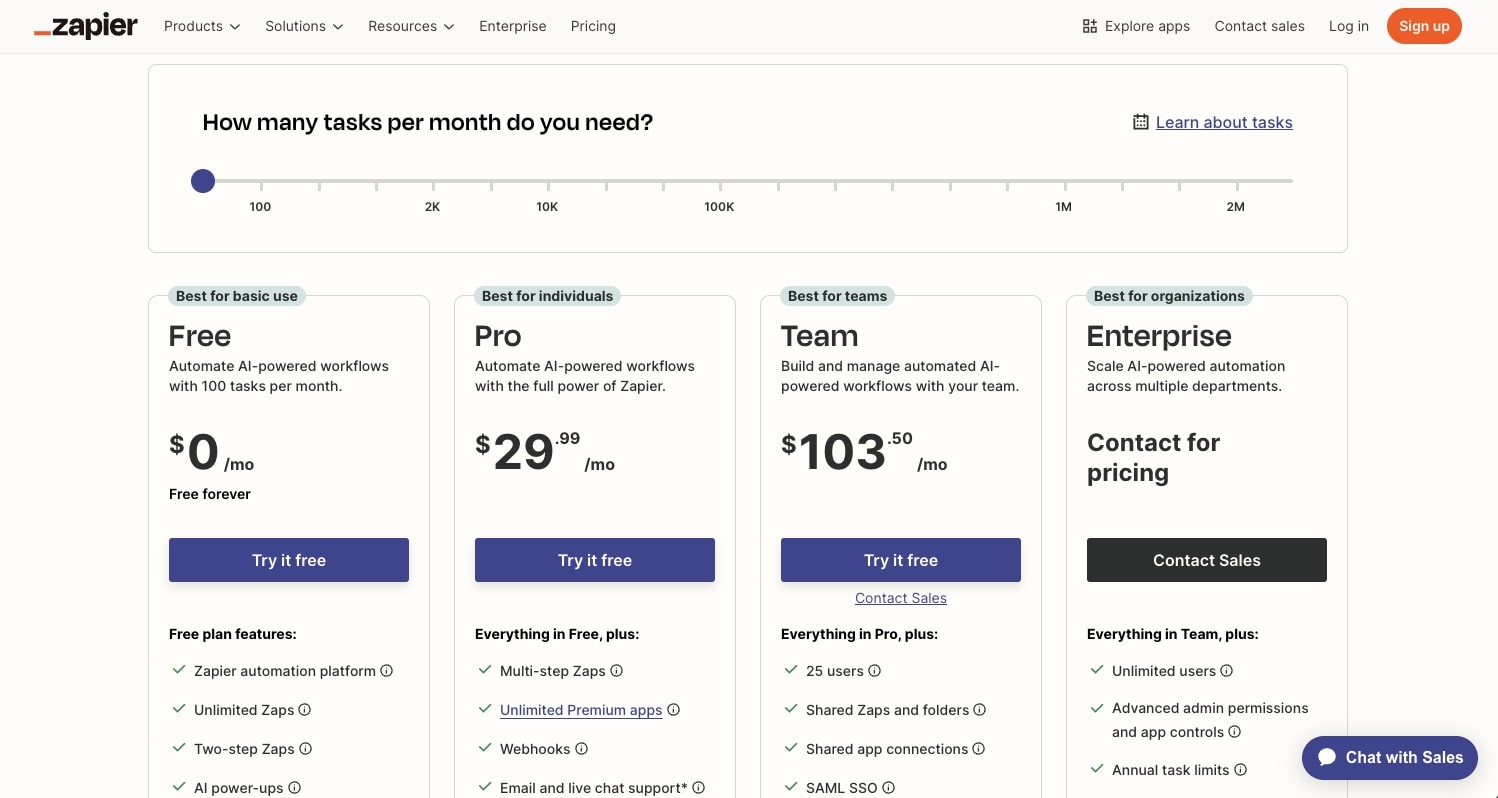
Here are Zapier's pricing plans:
- Free ($0/month): 100 tasks per month, unlimited Zaps/Tables/Interfaces, two-step Zaps, and Zapier Copilot
- Professional (starting at $29.99/month): Multi-step Zaps, unlimited premium apps, webhooks, email and live chat support, AI fields, and conditional form logic
- Team (starting at $103.50/month): Everything in Professional plus 25 users, shared Zaps and folders, shared app connections, SAML SSO, and priority support
- Enterprise (contact for pricing): Everything in Team plus unlimited users, advanced admin permissions and app controls, advanced deployment options, annual task limits, observability, and technical account manager
If you want to compare the different plans, you can check out the pricing page here.
Zapier reviews
Here's what customers rate Zapier on third-party review sites:
- G2: 4.5/5 star rating (from +1,510 user reviews)
- Capterra: 4.7/5 star rating (from +3,017 user reviews)
4. StackAI

- Best for: Enterprise companies building AI agents with strict compliance requirements
- Pricing: Free plan available, Enterprise pricing is custom
- What I like: The interface is beautiful and it's built from the ground up for enterprise-grade security and compliance
StackAI is an AI agent builder designed for enterprise companies. It allows you to create automated workflows that can act as "AI workers" to help you automate repetitive tasks internally.
The platform is very AI-native, so it's great at helping with data extraction, knowledge retrieval, and then taking all that and doing document generation. This way you can automate many parts of your reporting across different organizations and automatically generate documents that can be given to stakeholders and the rest of your team.
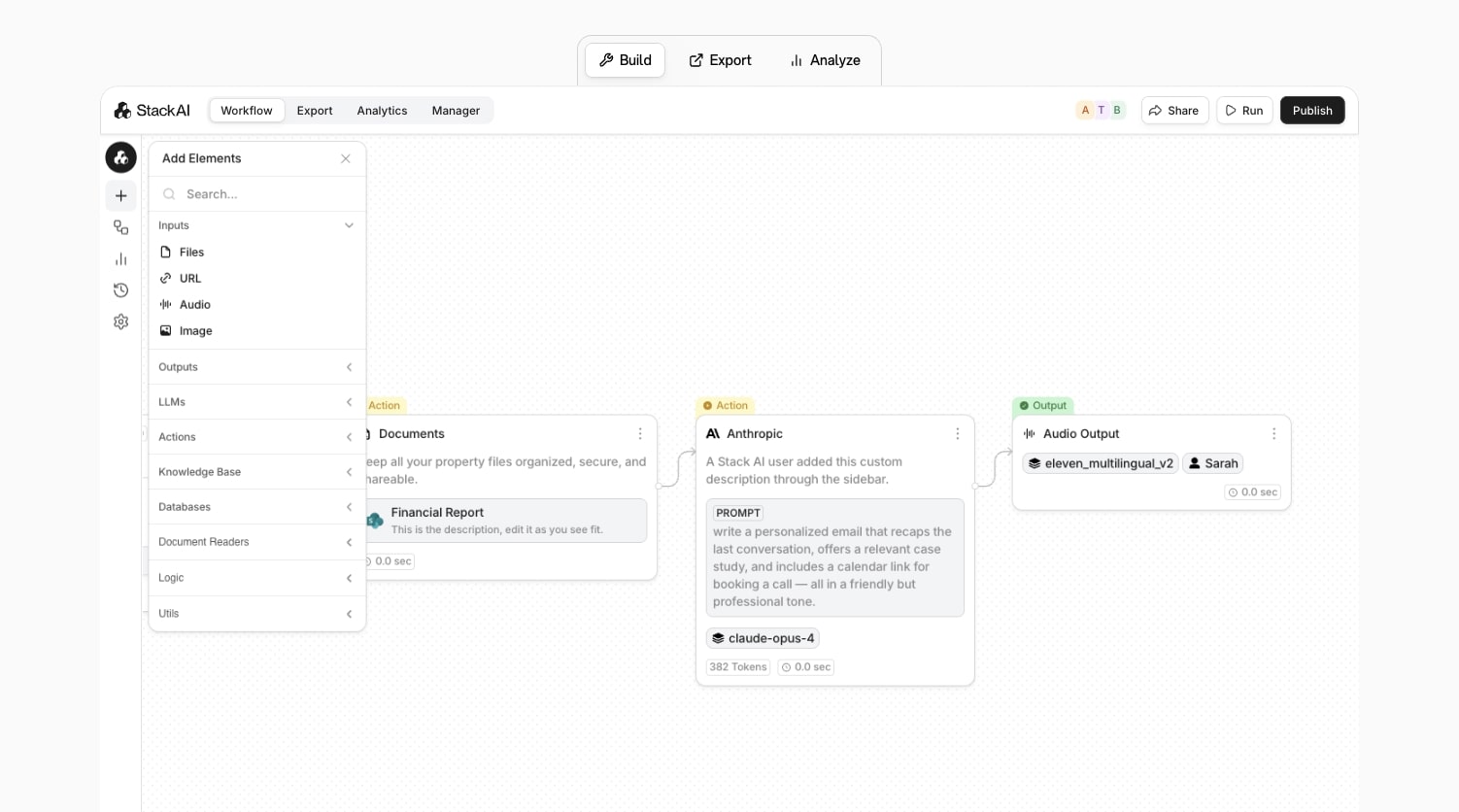
Top use cases
Here are some of the top use cases for StackAI:
- Finance: You can use StackAI to automate KYC, AML, regulatory reporting, and any banking workflows that require enterprise-grade compliance.
- Insurance: You can deploy AI agents that automate your claim processing, verification, and any policy admin work.
- Education: You can build automations for universities and academic programs to create AI-powered applications that can help with student success, improve teaching, and reduce any admin overhead.
Pros and cons
Here are some of the pros with StackAI:
- It has a beautiful AI agent building interface that I absolutely love
- It has all scalability and security requirements for enterprise companies (think SOC 2 compliance, GDPR, etc.)
- Can integrate with advanced LLM models
Here are some of the cons with StackAI:
- The pricing is not that transparent, which is to be expected of enterprise tools
- It's limited in its community resources as it's still an emerging platform
- It can have a longer implementation time compared to some other tools on this list like Gumloop or Zapier
StackAI pricing
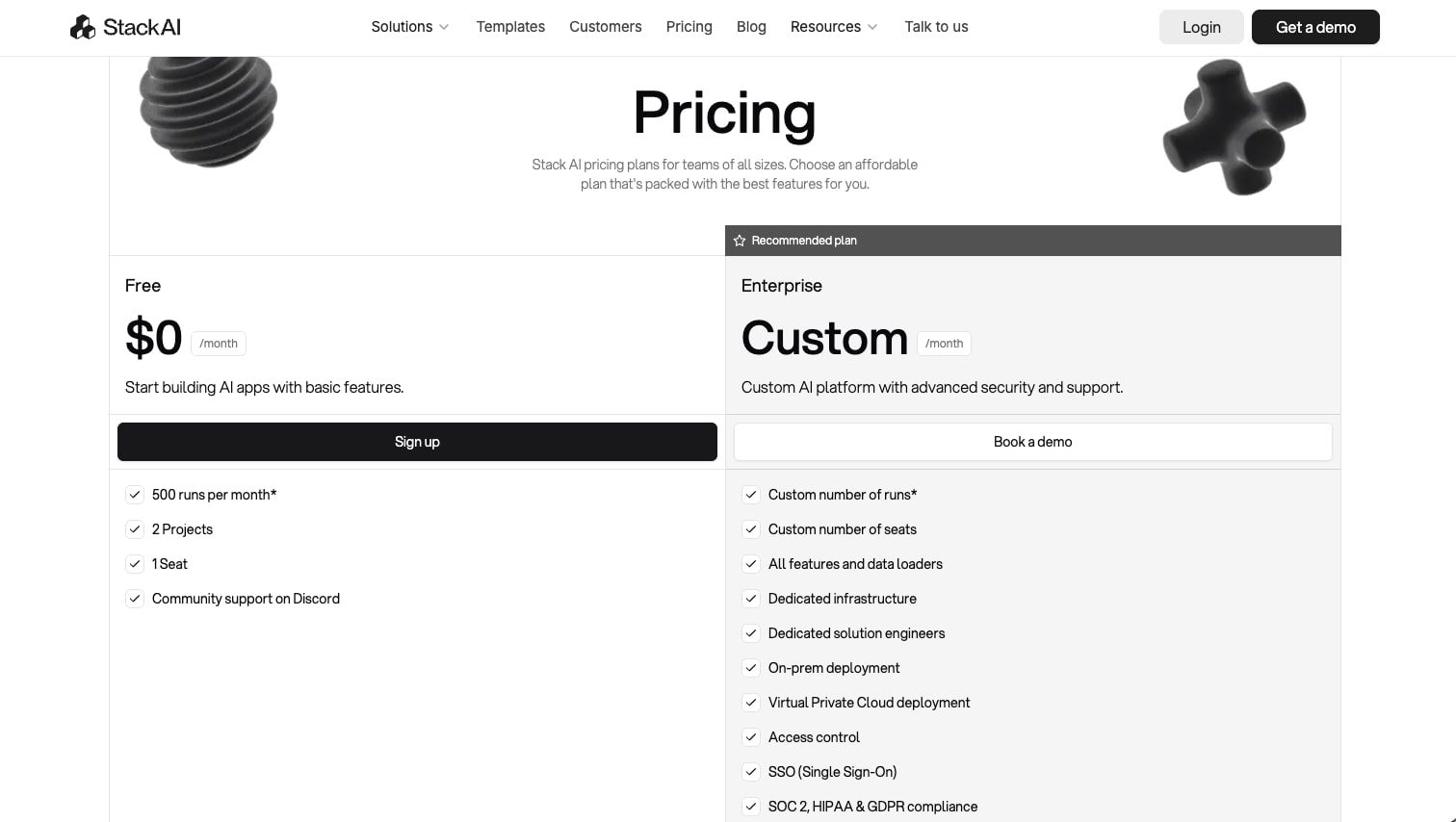
Here are StackAI's pricing plans:
- Free ($0/month): 500 runs per month, 2 projects, 1 seat, and community support on Discord
- Enterprise (custom pricing): Custom number of runs, custom number of seats, all features and data loaders, dedicated infrastructure, dedicated solution engineers, on-prem deployment, Virtual Private Cloud deployment, access control, SSO (Single Sign-On), and SOC 2, HIPAA & GDPR compliance
If you want to compare the different plans, you can check out the pricing page here.
StackAI reviews
Here's what customers rate StackAI on third-party review sites:
- G2: 4.7/5 star rating (from +33 user reviews)
- Slashdot: 4.8/5 star rating (from +38 user reviews)
5. Lindy AI

- Best for: Building AI agents for customer support and sales operations
- Pricing: Free plan available, paid plans start at $49.99/month
- What I like: The chat interface makes it dead simple to create AI agents without any technical knowledge
Lindy AI is an AI agent builder designed to act as an AI employee. It has a simple chat interface that allows you to create agents across customer support and sales operations.
Similar to some other tools on this list, you can connect your existing tech stack to it and let AI take over the decision-making process between them. And you can do all of this in a no-code interface, making it quite easy to use.
Top use cases
Here are some of the top use cases for Lindy AI:
- Customer support: You can build AI agents that reply to customers, train them on your past support tickets and current documentation, create support Slack bots that can handle queries in Slack, and more.
- Sales: You can create your own AI SDR that can do custom outreach, keep your CRM up to date, qualify leads, and even enrich lead data.
- Voice: Lindy AI now has an AI phone agent (named Gaia) that can schedule calls and handle conversations 24 hours a day. And it's all powered by Deepgram Flux.
Pros and cons
Here are some of Lindy AI's pros:
- Great for customer support and sales use cases as they have an ecosystem of tools for this space
- The chatbot interface makes it easy to create your first automated workflow
- You can use different LLM models to help you qualify leads and automate your outreach process
Here are some of the cons with Lindy AI:
- Pricing can get expensive for more complex workflows (not the cheapest tool on this list)
- Not the best tool for advanced marketing or operations use cases
Overall, Lindy AI is a solid platform if you need to automate different parts of your customer support ops. And it's especially great if you want to leverage voice automations for handling phone services. However, if you are looking for a tool that can handle other use cases, it might be worth looking into a Lindy AI alternative.
Lindy AI pricing

Here are Lindy AI's pricing plans:
- Free ($0/month): 400 credits per month, up to 40 tasks, 1M characters knowledge base, and 100+ integrations
- Pro ($49.99/month): 5,000 credits per month, up to 1,500 tasks, invite team members, 30 phone calls per month, and 20M characters knowledge base
- Business ($199.99/month): 20,000 credits per month, everything in Pro, unlimited phone calls, and 30+ supported phone call languages
- Enterprise (custom pricing): As many credits as you need, everything in Business, priority support, enterprise-grade security, and dedicated account management
If you want to compare the different plans, you can check out the pricing page here.
Lindy AI reviews
Here's what customers rate Lindy AI on third-party review sites:
- G2: 4.9/5 star rating (from +169 user reviews)
- Capterra: 3.5/5 star rating (from +2 user reviews)
6. UiPath

- Best for: Enterprise-level robotic process automation (RPA) for regulated industries
- Pricing: Starts at $25/month for Basic, Standard and Enterprise require custom pricing
- What I like: Built specifically for large organizations in healthcare, finance, and public sector that need strict compliance
UiPath is an enterprise-level AI-augmented tool designed to help you with robotic process automation (RPA). You can use it for financial services, healthcare, manufacturing, or public sector operations. It's a bit different than some other tools we've covered on this list as it does lean more on the non-tech enterprise side of things.
You can use UiPath to orchestrate different workflows, from helping with student onboarding at a university to automating real-time patient care, and even create AI agents for airline operations.
Top use cases
Here are some of the top use cases of UiPath:
- Healthcare: You can use the platform to create different automations like referral processing, claims operations, care management, revenue cycle management, and even supply chain admin tasks.
- Banking and financial services: You can build workflows around loan origination, KYC, wealth management client onboarding, and a ton more.
- Insurance: You can build automated workflows that can handle claims, policies, underwriting, and more.
Pros and cons
Here are some of the pros of using UiPath:
- Built for enterprise companies that need advanced security and compliance measurements
- Designed for developers so you can build custom solutions internally using RPA
- Can scale for large businesses
Here are some of the cons of using UiPath:
- The pricing isn't that transparent
- Will require a technical team to implement
- May have longer implementation times compared to some other tools on this list
Overall, UiPath fits a very specific use case. It's not the best tool if you're a startup or in the tech industry. But if you're a large company that works in the public sector and you require lots of rules and regulations, this is a platform to look into.
UiPath pricing

Here are UiPath's pricing plans:
- Basic (starting at $25/month): Basic personal automations with limited scale, 99.9% uptime, and Bronze support
- Standard (contact sales): Enterprise automations with agents, document extraction, enhanced governance, and unlimited scale
- Enterprise (contact sales): Everything in Standard plus self-healing UI automation, process optimization, and advanced security features
If you want to compare the different plans, you can check out the pricing page here.
UiPath reviews
Here's what customers rate UiPath on third-party review sites:
- G2: 4.6/5 star rating (from +7,251 user reviews)
- Capterra: 4.6/5 star rating (from +720 user reviews)
7. IFTTT
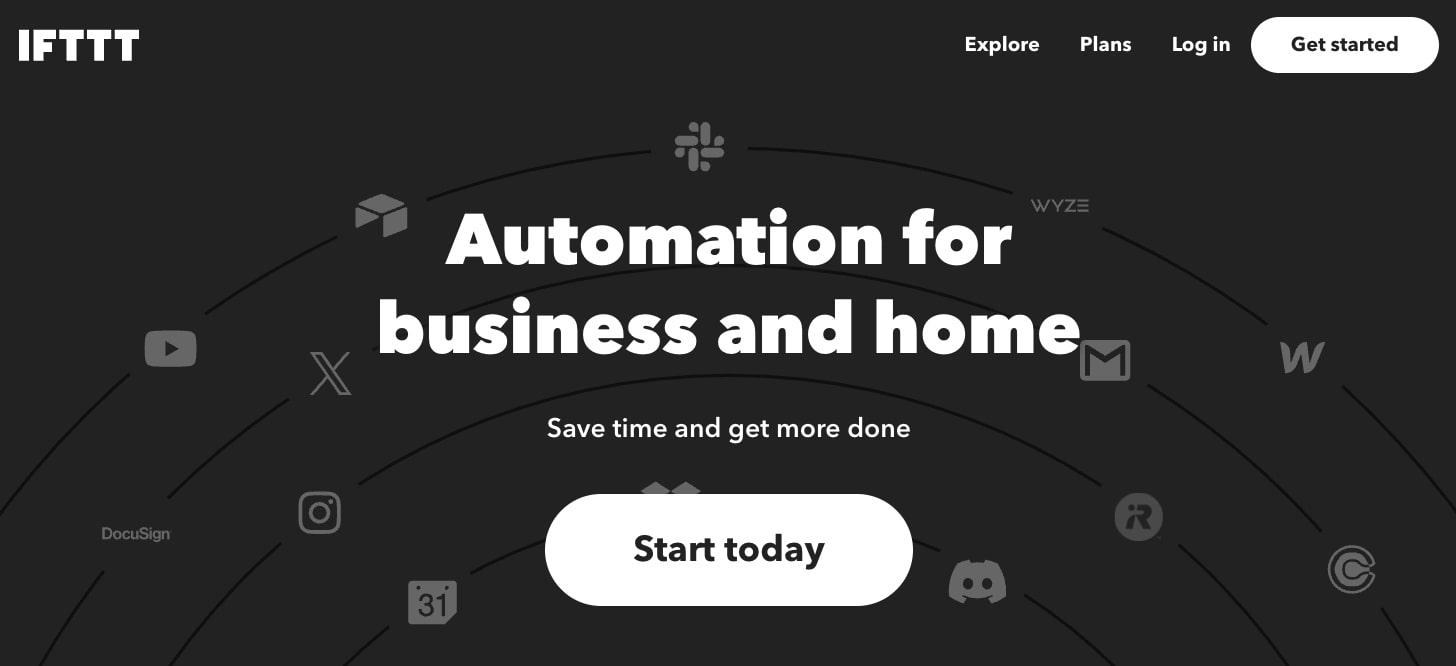
- Best for: Personal automations and simple smart home integrations
- Pricing: Free plan available, paid plans start at $3.99/month
- What I like: It's hands down the most affordable automation tool on the market and super simple to use
IFTTT is one of the first automation platforms to hit the market. It's actually the first tool I ever discovered over 10 years ago to create automations with. It's best for personal automations like smart home devices at home, but there are a few use cases for business ops that you can also use.
Top use cases
Here are some of the top use cases for IFTTT:
- Create Google Calendar events based off of specific triggers or actions
- Automate Instagram and X posting
- Create automations across Telegram to Discord or RSS feeds
As you can see, the use cases for IFTTT are quite simple. It's probably not the best tool for complex workflow management. Like if you're using Salesforce, then you probably don't want to use this tool. But if you're using simple automations across your Google Workspace or social media apps, this can be a really great budget-friendly alternative to Power Automate.
Pros and cons
Here are some of the pros with IFTTT:
- Hands down the cheapest automation platform on the market
- Very easy to use and even has an iOS and Android app
- It's used by thousands of people so it's quite reliable
Here are some of the cons with IFTTT:
- Its simplicity means it can't handle advanced workflows
- Doesn't have AI capabilities like some other tools on this list
- Doesn't have all the integrations you might need with a modern tech stack
Overall, it's great for personal use cases, but for more advanced business workflows, it's probably not the best alternative to use.
IFTTT pricing
Here are IFTTT's pricing plans:
- Free ($0/month): 2 Applets, standard Applet speeds, DIY or use published Applets, unlimited Applet runs, free mobile app access, and simple no-code integrations
- Pro ($3.99/month): 20 Applets, fastest Applet speeds, multi-action Applets, webhooks, Twitter Applets, increased rate limits, exclusive triggers and actions, and customer support
- Pro+ ($11.99/month): Unlimited Applets, everything in Pro, AI services, connect multiple accounts, use queries and filter code, and prioritized customer support
If you want to compare the different plans, you can check out the pricing page here.
IFTTT reviews
Here's what customers rate IFTTT on third-party review sites:
- G2: 4.5/5 star rating (from +114 user reviews)
- Capterra: 4.6/5 star rating (from +219 user reviews)
8. Make

- Best for: Small startups and solo operators on a budget building AI-powered automations
- Pricing: Free plan available, paid plans start at $10.59/month
- What I like: It's affordable and has over 2,500 pre-built app integrations to get you started quickly
Make (formerly Integromat) is a widely used workflow builder very similar to Zapier or n8n. In fact, for a long time it was the alternative to those tools because of its affordability and price point. But since then, a lot of other tools like Gumloop have also popped up that can do the same things.
Make is great for any startup or solo operator looking to build AI-powered automations in a drag-and-drop interface. I would say it fits into the camp of people who use n8n, but it's designed for non-technical users (whereas n8n is a bit more technical).
Top use cases
Here are some of the top use cases for Make:
- Marketing: Create automated workflows that can integrate with your email marketing platform, HubSpot, Facebook ads, social media scheduling, and more.
- Sales: Create automated outreach campaigns, build prospecting lists, and integrate with tools like QuickBooks to handle invoices.
- Operations: Build project management workflows with tools like Miro and Notion, automate company data and spreadsheets, handle supply chain management, and more.
Pros and cons
Here are some of the pros with Make:
- Simple to use tool that can handle most automations
- Can integrate with MCP servers to connect to those apps
- Allows you to connect LLM models to build AI agents
- Includes over 7,900 app templates
Here are some of the cons with Make:
- The user interface can feel a bit outdated and clunky
- Not the most stable platform when compared to tools like Zapier or Gumloop
Overall, Make is a solid platform if you need to build simple automations and you're on a budget. It's great for small startups experimenting with AI and even agencies that want to build automations for small businesses. But, if you’re looking for something a bit more AI-native, it might be worth looking into a Make alternative.
Make pricing

Here are Make's pricing plans:
- Free ($0/month): 1,000 credits per month, no-code visual workflow builder, 2,000+ apps, routers and filters, and 15-minute minimum interval between runs
- Core ($10.59/month for 10k credits): Unlimited active scenarios, scheduled scenarios down to the minute, increased data transfer limits, and access to the Make API
- Pro ($18.82/month for 10k credits): Everything in Core plus priority scenario execution, custom variables, and full-text execution log search
- Teams ($34.12/month for 10k credits): Everything in Pro plus teams and team roles, and create/share scenario templates
- Enterprise (custom pricing): Everything in Teams plus custom functions support, enterprise app integrations, 24/7 support, access to Value Engineering team, and overage protection
If you want to compare the different plans, you can check out the pricing page here.
Make reviews
Here's what customers rate Make on third-party review sites:
- G2: 4.6/5 star rating (from +264 user reviews)
- Capterra: 4.8/5 star rating (from +406 user reviews)
9. Workato

- Best for: Enterprise companies with hundreds or thousands of employees automating at scale
- Pricing: Custom enterprise pricing (contact sales for details)
- What I like: Built-in MCP server integrations and enterprise-level security make it easy to connect AI platforms
Workato is an enterprise-grade agentic platform that is built for large companies that want to automate internal tasks. The platform is very similar to UiPath in that it feels more like a SaaS + agency service compared to a self-serve tool that you can start building automations with today.
If platforms like Make or Zapier feel like everyday tools for startups, then Workato is designed to help businesses with hundreds (or even thousands of employees).
Top use cases
Here are some of Workato's top use cases:
- Customer experience: Create customer experience "genies" that can automatically orchestrate customer insights and surveys and turn them into actionable follow-ups.
- HR & recruiting: Create job requirement agents that can tailor job descriptions, prepare team members for interviews, and even create custom questions for each role.
- Security: Create SecOps agents that can monitor security alerts, analyze threats, and execute on tasks you train them on.
Pros and cons
Here are some of the pros with Workato:
- Has integrations with MCP servers so you can connect to most AI platforms
- Has built-in enterprise-level scalability and security
- Used by large companies like Booking.com, Atlassian, Adobe, and more
Here are some of the cons with Workato:
- Feels like most enterprise software, so not the most flattering thing to look at
- Doesn't have self-serve options and you need to book a demo to see how it works
Overall, Workato is another one of those enterprise-level tools. It's great if you're a large company trying to pilot with different AI tools, but it may not be the best if you are a startup who's trying to move fast.
Workato pricing
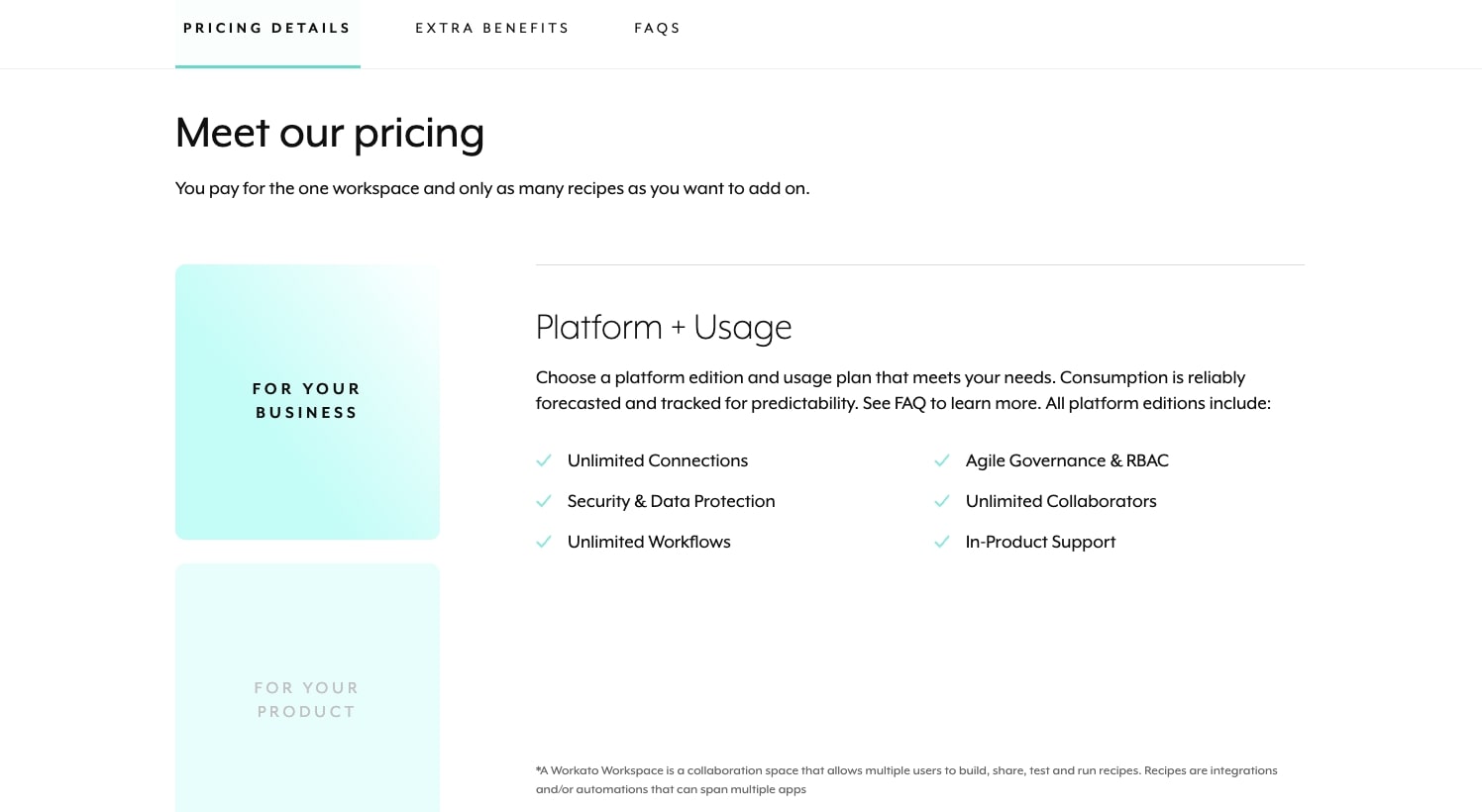
Workato offers custom enterprise pricing based on platform edition and usage plans. All platform editions include unlimited connections, security and data protection, unlimited workflows, agile governance and RBAC, unlimited collaborators, and in-product support.
You'll need to contact their sales team for specific pricing details tailored to your organization's needs.
If you want to learn more about pricing, you can check out their pricing page here.
Workato reviews
Here's what customers rate Workato on third-party review sites:
- G2: 4.7/5 star rating (from +647 user reviews)
- Capterra: 4.6/5 star rating (from +84 user reviews)
10. Tray.ai
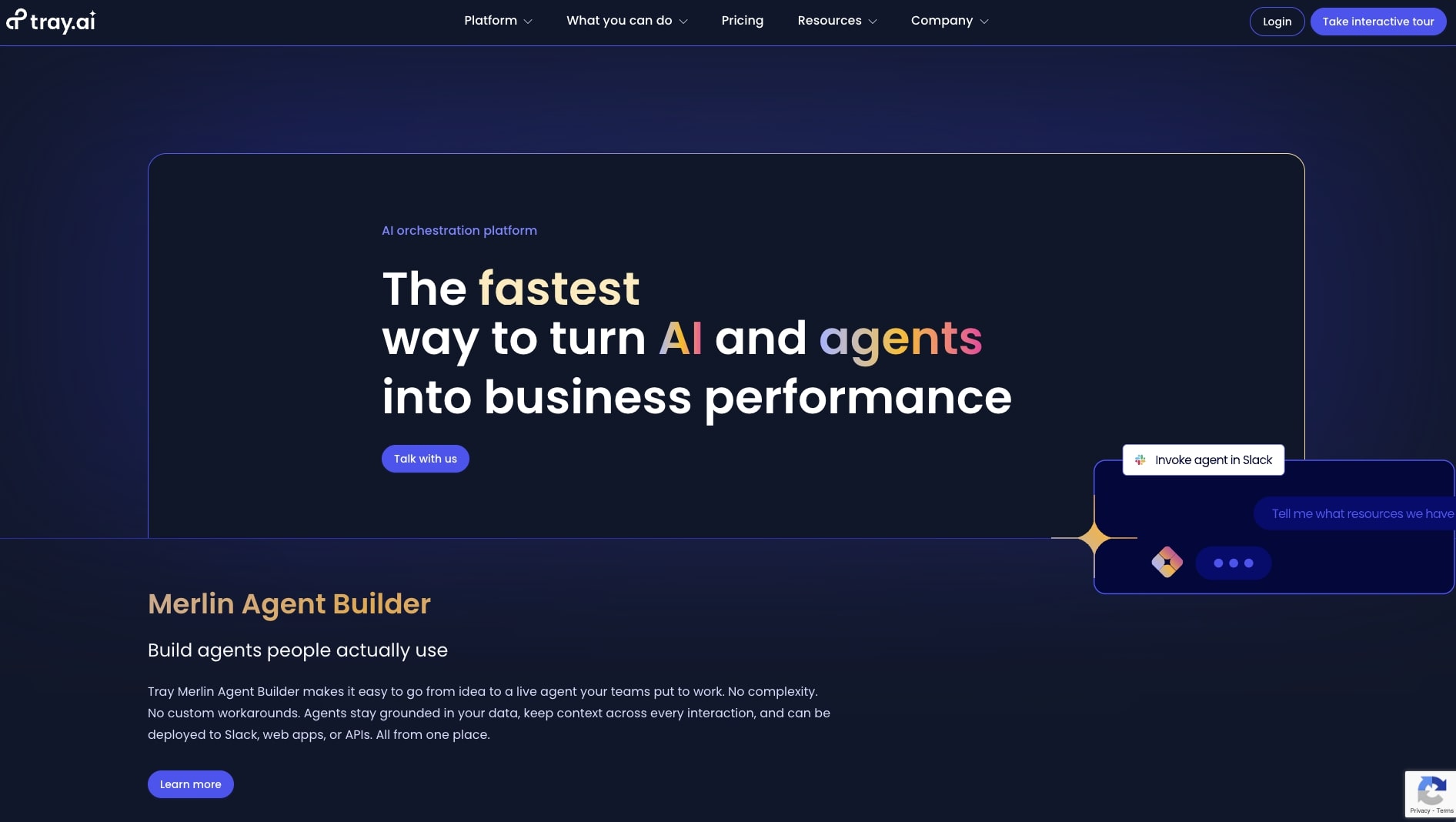
- Best for: Enterprise teams building AI agents across HR, IT, RevOps, and Security
- Pricing: Custom pricing for Pro, Team, and Enterprise plans
- What I like: Flexible iPaaS platform that connects your data warehouse, LLMs, and existing apps in one place
Tray.ai is an iPaaS platform that can help you build AI agents across different orgs like HR, IT, RevOps, and Security.
The platform works by first connecting your existing apps like Salesforce, Workday, Greenhouse, etc. From there, it integrates with your data warehouse whether it's through Snowflake, Redshift, or Databricks. And it connects to an LLM (either from OpenAI or Amazon Bedrock). And then you can build automated workflows and agents that are connected to all of these.
Top use cases
Here are some of the top use cases with Tray.ai:
- RevOps: Connect tools like Salesforce and NetSuite to an OpenAI model to automate everything from lead generation to cash collected.
- IT and Security: Connect tools like ServiceNow and Slack to help resolve tickets and create workflows that can flag high-priority issues.
- HR and People Ops: Connect tools like Workday and Greenhouse to automate different parts of the hiring workflow.
Pros and cons
Here are some of the pros with Tray.ai:
- Flexible tool that can integrate with tons of tools using different app connectors
- Many users report that it has an easy setup process
- Has simple drag-and-drop features that make it easy to set up workflows
Here are some of the cons with Tray.ai:
- The pricing is not that transparent and can get quite expensive
- Has a long onboarding time (reported by many users on G2)
Overall, Tray.ai is an enterprise-level tool designed for businesses that have a lot of employees. There may be a long implementation time, but if you need specific use cases in IT or RevOps, it can be a great alternative to using Microsoft's Power Automate.
Tray.ai pricing
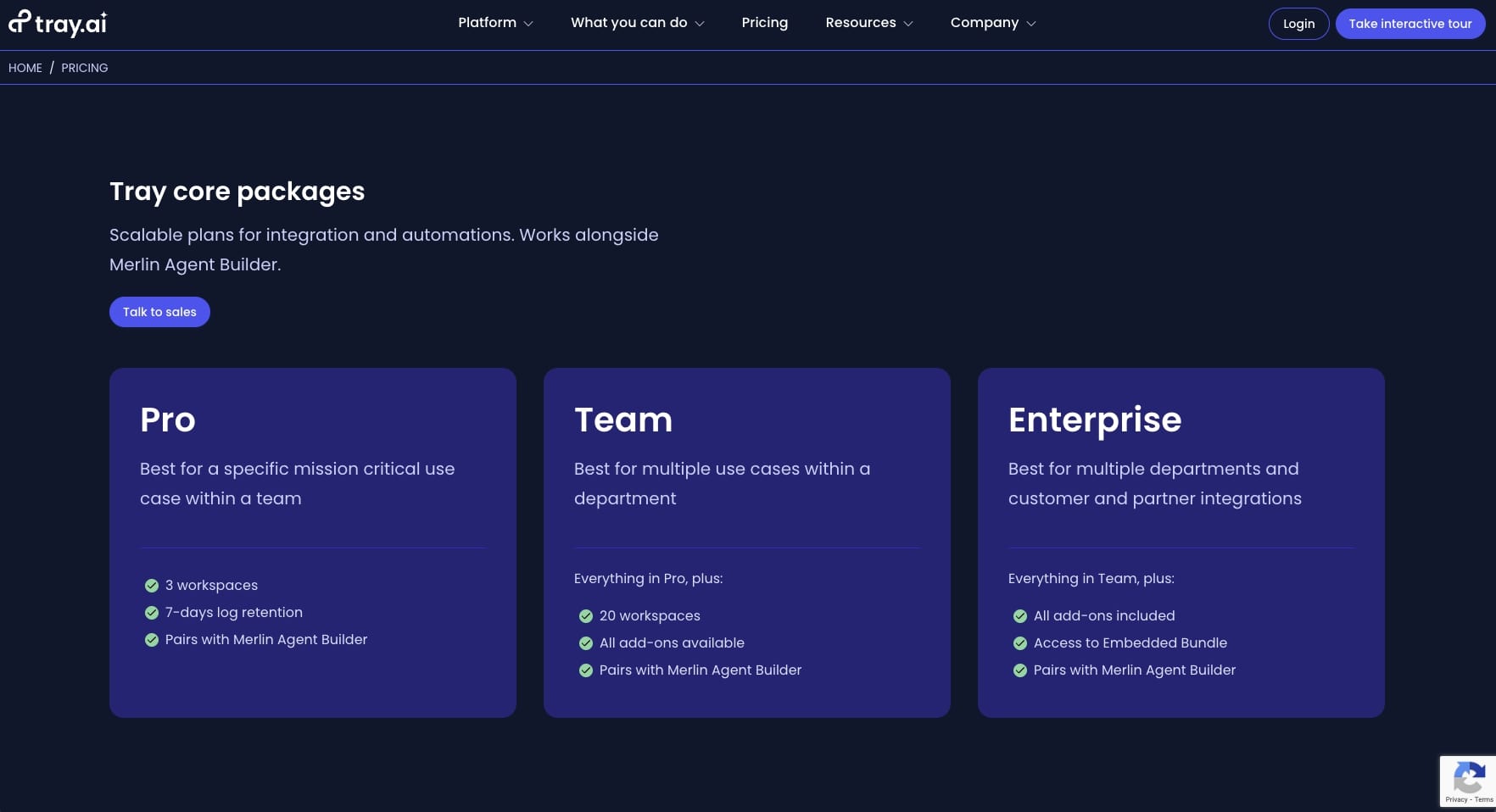
Here are Tray.ai's pricing plans:
- Pro: 3 workspaces, 7-days log retention, and pairs with Merlin Agent Builder
- Team: Everything in Pro plus 20 workspaces and all add-ons available
- Enterprise: Everything in Team plus all add-ons included and access to Embedded Bundle
All plans pair with Merlin Agent Builder. You'll need to contact their sales team for specific pricing details.
If you want to learn more about pricing, you can check out their pricing page here.
Tray.ai reviews
Here's what customers rate Tray.ai on third-party review sites:
- G2: 4.5/5 star rating (from +156 user reviews)
- Capterra: 4.9/5 star rating (from +11 user reviews)
AI now gives us automation superpowers
The automation software space has completely changed in the past two years.
We went from simple "if this, then that" logic to building full AI agents that can make decisions, handle complex workflows, and actually feel like digital employees. It's wild.
Microsoft Power Automate is a great tool, but depending on where you're at in your business, there are better alternatives out there. Whether you're a solo operator trying to automate lead gen, or you're running a 500-person company that needs enterprise-grade compliance, there's a tool on this list that fits.
My personal recommendation is that you're looking for something AI-native that’s free and easy to start using, start with Gumloop. If you're more technical and want full control, check out n8n. And if you need something enterprise-level with strict security requirements, look into StackAI or UiPath.
Most of these tools have free plans or trials, so you can actually test them out before committing. Play around with a few, see which one gets you excited, and start automating stuff (start simple).
Because at the end of the day, the goal is to spend less time on repetitive tasks and more time on the work that actually matters. So get automating!
Read related articles
Check out more articles on the Gumloop blog.
Create automations
you're proud of
Start automating for free in 30 seconds — then scale your
superhuman capabilities without limits.


















